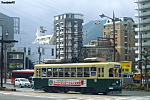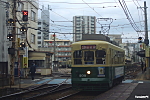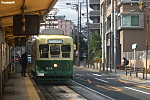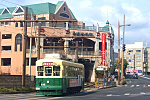Not logged in | Log in | Sign Up

Search Photos
Hitachi Nagasaki Denki Kidō 201 series #209
11 february 2019 - Nagasaki (Nagasaki Pref.), Hamaguchimachi (長崎県長崎市浜口町), National Route 206. This photo shows the air-conditioning units added in 1987 rather well. Japanese Wikipedia claims that some big changes were made to the external appearance of these cars when strengthening the body for air-con installation, but I struggle to see any when comparing with a 1954 photo, aside from perhaps changes to the side scroll location and the front window shape. The red bus in the background belongs to Nagasaki Ken`ei Kōtsū, a company that I somehow don`t have a single shot of...

Author: TranslatorPS 

Hitachi Nagasaki Denki Kidō 201 series #203
11 february 2019 - Nagasaki (Nagasaki Pref.), Ōbashimachi (長崎県長崎市大橋町), Urakami-shako (Urakami Depot) tram stop. All of the three-light signals seen in this photo (they always only show two lights) are shunting signals. Shunting signals of the exactly same style are used by practically all heavy railways in Japan, so it`s somewhat interesting to see them used in a tramway network as well. Signal 4 (under the red X) allows switching back on the mainline, as the track layout at the depot is quite inconvenient - in order to leave most of the depot tracks towards the city (as in head in the direction of this car), one has to pull out to the outbound platform and reverse on the mainline towards the city using one of the crossovers behind the tram in the photo. The other signals are used for pulling into one of the stabling tracks in the depot. Signal 8 seen above the platform to the right is also for entering the depot, however this is for cars on the inbound track which reverse using the platform where I`m standing. Quite a lot of shunting involved. The red X above signal 4 is to confirm point locking, as far as I remember.

Author: TranslatorPS 

Hitachi Nagasaki Denki Kidō 211 series #214
11 february 2020 - Nagasaki (Nagasaki Pref.), Nakazonomachi (長崎県長崎市中園町), National Route 206, Akasako tram terminus. A brief reprieve from the Kantō area in the form of nearly the edge of the country - Nagasaki. To start this short series off, a rather peculiar terminus structure: a single bi-directional platform (which by the way is the longest in the network, at 53 metres), split into three sectors. As such, three different cars can terminate here simultaneously. However for the same reason cars depart from here in reverse order of their arrival - first to arrive, last to leave. The points splitting off to the double-track section are right at the end of the platform (behind the photographer). Akasako is also the western-most tram stop in Japan.

Hitachi Nagasaki Denki Kidō 211 series #212
11 february 2019 - Nagasaki (Nagasaki Prefecture), Kawaguchimachi, Urakami-kaidō, near Genbaku-shiryōkan stop (長崎県長崎市川口町浦上街道), National Route 206. Two days after returning to Tokyo from the freezing north with the Japanese version of Ryanair (although the opinion didn`t come from my own flight as much as my dormmates`... or rather the cancellations. One of my friends was supposed to return only 5 hours later, she didn`t fly until two days later, the others none the better.), I jumped on another flight - to Nagasaki...City which one cannot have not heard of. As it stands today, it is the second and last atomic bomb attack target. Nonetheless, it`s just as important for having been the only city in Japan which conducted international trade for over 200 years. The city lies in a valley and can be divided into two major portions. For us the enthusiasts, however, the more important part will be the tram network. Since its opening in 1914, it has not lost a kilometre in the net total. Aside from moving one line in the 40s or 50s, the network has only been developed since the opening, with a total of 11.5 km of lines today. It`s powered by 600V DC, and runs on 1435 mm gauge tracks - unusually enough for Japan.


Author: TranslatorPS 




